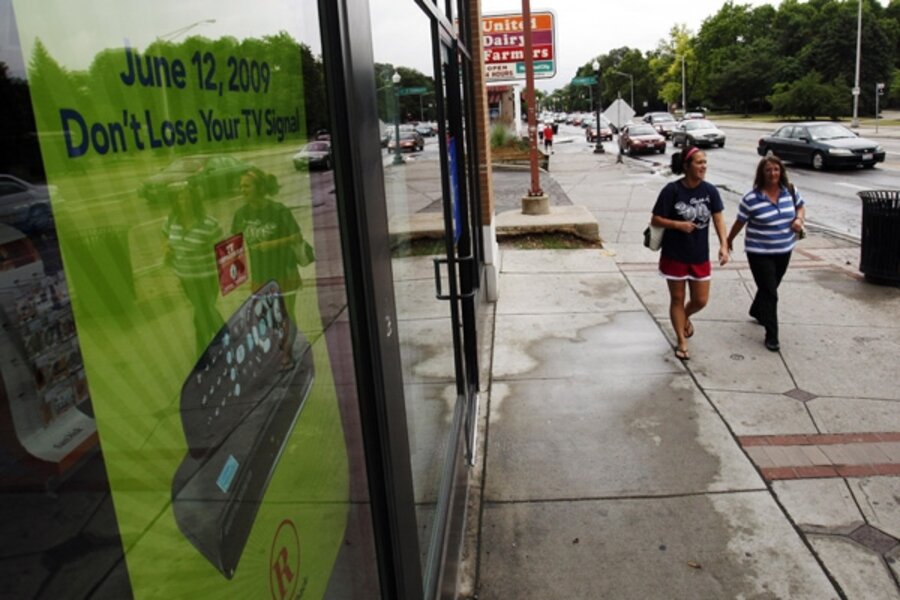Digital TV transition hits - what you need to know
Loading...
As the last analog signals wink out forever, completing a long-awaited technological upgrade that promises better things to come, an unwelcome jolt hits those who are still unprepared.
By midnight June 12, all the nation’s local television stations are expected to have changed over to a digital signal. Owners of older analog TVs who want to still receive free programming over the airwaves will have to install a converter box or be left staring at a blank screen.
An estimated 2.2 million to 2.8 million households are still unprepared for the changeover, according to research firms SmithGeiger and Nielsen, respectively.
Households with cable or satellite connections will not be affected, no matter the type or age of TV the customer has, since those companies already convert their signal back into analog. (But remember that any secondary household TVs not hooked up to cable – in a den, kitchen, or bedroom, for example – will be affected.)
In theory, owners of TVs with digital tuners, whether high-definition (HDTV) or not, should be fine too. (TVs bought in the last two years probably are digital.) These sets are already equipped to display digital signals transmitted over the airwaves.
But two hurdles may face anyone trying to watch over-the-air TV by the time they awake tomorrow:
You may need a better antenna.
Digital transmissions don’t carry as well as analog signals, and they require better signal strength to keep the picture from flickering off and on – or not appearing at all. Gone is the possibility of settling for a snowy, grainy, or wavy picture. Now it’s crystal clear or nothing, as our tech columnist discovered the hard way. Viewers may need to purchase a more powerful set-top antenna to pull in channels they are used to seeing. In some situations, they may even need to install an attic or rooftop antenna to get adequate service. The website antennaweb.org provides a handy calculator that shows how near your set is to transmission towers and what stations you might be expected to receive depending on the type of antenna you have.
You’ll need to re-calibrate your converter box.
Those installing a converter box now will need to calibrate it to find the new digital TV signals in their area – a simple process explained in the instructions with the box. But some of those signals will be changing as the analog signals are dropped. Stations may adjust their signal strengths too. Even viewers who installed their converter box months ago should re-calibrate it tomorrow and, to be safe, every once in awhile after that in case local stations make further changes. (Antennas may need adjusting, too.)
The above involves just enough nuisance and expense that it may send a few people in search of a good book or back to their radios for news and entertainment. Others will likely sign up for cable or satellite TV to avoid the hassle. (Those who don’t need or want more channels should ask for the least-expensive “basic” package, which may not be advertised by the company.) Still others may move more of their TV viewing online, watching shows at the networks’ own websites or on sites such as Hulu.com.
What’s the good news?
Well, the federal government pocketed about $20 billion from selling off the old airwaves spectrum to private companies that will be able to offer even more new digital wonders, such as enhanced cellphone services.
For viewers who manage to get their antenna and converter box issues settled, digital TV will mean a noticeably sharper picture, even on the same old set. Depending on where they live, it also may mean many more channels to view: Local stations now will have room to broadcast three or four digital channels where before they could broadcast only one in analog. (Note: These are new broadcast channels. Over-the-air viewers still won’t be able to see cable-only channels such as CNN or ESPN.)
Viewers with HDTVs will be able to enjoy some programs broadcast in high-definition without the need of a cable box or satellite dish.
Vouchers worth $40 toward the cost of a converter box (total cost: $40 to $100) are still available from the federal government (limit: two per household). In addition, viewers may be able to receive free help in setting up their converter box and determining their antenna needs.
To apply for vouchers, receive help, or just learn more about the digital transition, go to www.DTV.gov or call the US government’s hotline at 1-888-CALL-FCC (1-888-225-5322).






